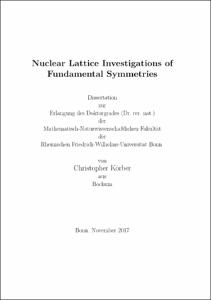Nuclear Lattice Investigations of Fundamental Symmetries

Nuclear Lattice Investigations of Fundamental Symmetries

| dc.contributor.advisor | Luu, Thomas | |
| dc.contributor.author | Körber, Christopher | |
| dc.date.accessioned | 2020-04-25T01:30:11Z | |
| dc.date.available | 2020-04-25T01:30:11Z | |
| dc.date.issued | 10.04.2018 | |
| dc.identifier.uri | https://hdl.handle.net/20.500.11811/7540 | |
| dc.description.abstract | Fundamental symmetries (and their violations) play a significant role in active experimental searches of Beyond the Standard Model (BSM) signatures. An example of such phenomena is the neutron Electric Dipole Moment (EDM), a measurement of which would be evidence for Charge-Parity (CP) violation not attributable to the basic description of the Standard Model (SM). Another example is the strange scalar quark content of the nucleon and its coupling to Weakly Interacting Massive Particles (WIMPs), which is a candidate model for Dark Matter (DM). The theoretical understanding of such processes is fraught with uncertainties and uncontrolled approximations. On the other hand, methods within nuclear physics, such as Lattice Quantum Chromodynamics (LQCD) and Effective Field Theories (EFT), are emerging as powerful tools for calculating non-perturbatively various types of nuclear and hadronic observables. This research effort will use such tools to investigate phenomena related to BSM physics induced within light nuclear systems. As opposed to LQCD which deal with quarks and gluons, in Nuclear Lattice Effective Field Theory (NLEFT) individual nucleons – protons and neutrons – form the degrees of freedom. From the symmetries of Quantum Chromodynamics (QCD), one can derive the most general interaction-structures allowed on the level of these individual nucleons. In general, this includes an infinite number of possible interactions. Utilizing the framework of EFTs, more specifically for this work Chiral Perturbation Theory (χPT), one can systematically expand the nuclear behavior in a finite set of relevant nuclear interactions with a quantifiable accuracy. Fundamental parameters of this theory are related to experiments or LQCD computations. Using this set of effective nuclear interaction-structures, one can describe many-nucleon systems by simulating the quantum behavior of each involved individual nucleon. The 'ab initio' method NLEFT introduces a spatial lattice which is finite in its volume (FV) and allows to exploit powerful numerical tools in the form of statistical Hybrid Monte Carlo (HMC) algorithms. The uncertainty of all three approximations – the statistical sampling, the finite volume and the discretization of space – can be analytically understood and used to make a realistic and accurate estimation of associated uncertainty. In the first part of the thesis, χPT is used to derive nuclear interactions with a possible BSM candidate up to Next-to-Leading Order (NLO) in the specific case of scalar interactions between DM and quarks or gluons. Following this analysis, Nuclear Matrix- Elements (NMEs) are presented for light nuclei (2H, 3He and 3H), including a complete uncertainty estimation. These results will eventually serve as the benchmark for the many-body computations. In the second part of this thesis, the framework of NLEFT is briefly presented. It is shown how one can increase the accuracy of NLEFT by incorporating few-body forces in a non-perturbative manner. Finite-Volume (FV) and discretization effects are investigated and estimated for BSM NME on the lattice. Furthermore, it is displayed how different boundary conditions can be used to decrease the size of FV effects and extend the scope of available lattice momenta to the range of physical interest. | |
| dc.language.iso | eng | |
| dc.rights | In Copyright | |
| dc.rights.uri | http://rightsstatements.org/vocab/InC/1.0/ | |
| dc.subject | Nuclear Physics | |
| dc.subject | Effective Field Theory | |
| dc.subject | Chiral Perturbation Theory | |
| dc.subject | Lattice Field Theory | |
| dc.subject | Ab Initio Calculations | |
| dc.subject | Few-Nucleon Systems | |
| dc.subject | Nucleon-Nucleon Interactions | |
| dc.subject | Particle Dark Matter | |
| dc.subject.ddc | 530 Physik | |
| dc.title | Nuclear Lattice Investigations of Fundamental Symmetries | |
| dc.type | Dissertation oder Habilitation | |
| dc.publisher.name | Universitäts- und Landesbibliothek Bonn | |
| dc.publisher.location | Bonn | |
| dc.rights.accessRights | openAccess | |
| dc.identifier.urn | https://nbn-resolving.org/urn:nbn:de:hbz:5n-50331 | |
| ulbbn.pubtype | Erstveröffentlichung | |
| ulbbnediss.affiliation.name | Rheinische Friedrich-Wilhelms-Universität Bonn | |
| ulbbnediss.affiliation.location | Bonn | |
| ulbbnediss.thesis.level | Dissertation | |
| ulbbnediss.dissID | 5033 | |
| ulbbnediss.date.accepted | 14.03.2018 | |
| ulbbnediss.institute | Mathematisch-Naturwissenschaftliche Fakultät : Fachgruppe Physik/Astronomie / Helmholtz-Institut für Strahlen- und Kernphysik (HISKP) | |
| ulbbnediss.fakultaet | Mathematisch-Naturwissenschaftliche Fakultät | |
| dc.contributor.coReferee | Meißner, Ulf-G. |
Dateien zu dieser Ressource
Das Dokument erscheint in:
-
E-Dissertationen (4077)




